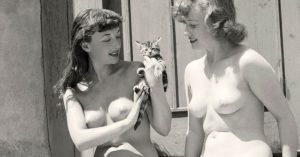
A charming picture of La Belle Sauvage taken by Stephen Glass in the mid-1950s. From the original negative. Model unknown.
Somewhat off-topic, it was around this time that the publishers Cassell, who were founded in 1852 at La Belle Sauvage Yard, Ludgate Hill, commissioned a nude statue of Princess Pocahontas by David McFall for their new premises at Red Lion Square. It was to replace Eric Gill’s “little naked lady. with tiger skin and bow and arrows,” the house Colophon lost when their former home in Belle Sauvage Yard was destroyed by German bombing.
The larger-than-life statue of Pocahontas graced the entrance of their headquarters. McFall saw Pocahontas, the original Belle Sauvage, as something of an Amazonian creature. He sculpted her looking at a tobacco plant as she came from Virginia. Vandals immediately took a liking to the plant and the feathers, which they unceremoniously amputated. McFall recalls how “an enter-prising conductor of an electric trolley bus (they had them in those days)” found the feathers in some bushes and brought them into a grateful Cassells.
As Cassell’s fortunes waned, the firm moved from their imposing offices on Red Lion Square, taking the statue with them. Some people believe that a private collector purchased it at auction in 1996, which is indeed a shame, as it has never been seen since. I think central London could do with a delightful nude statue of Pocahontas. Do any readers remember this statue? If so please post in the comments.

Who was Pocahontas?
Pocahontas was the daughter of the Indian Chief Powhatan. Upon marrying John Rolfe, a tobacco planter, she traveled to England with him in 1616. There, she was received as royalty and captivated London society. As she prepared to return to America, she fell ill with smallpox and passed away in Gravesend, where she was buried, in March 1617.

